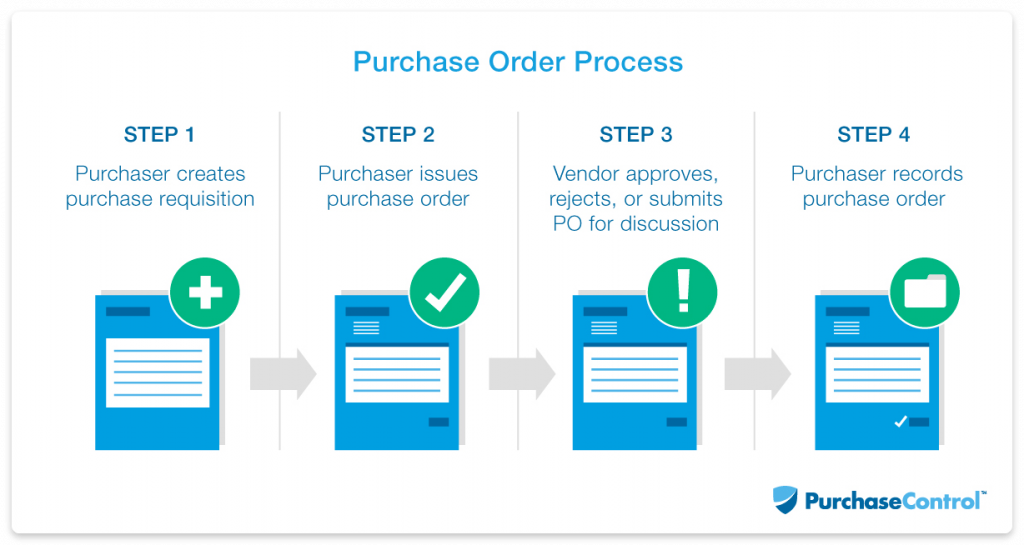Purchase order
Using purchase orders is crucial for a well-managed purchasing process. They can help you control your spending, track your inventory and ordering supplies, and streamline the process of purchasing goods.
Purchase order definition
A Purchase Order (PO) number is a unique identifier given to a purchase order, which outlines the buyer’s intent to procure specific goods or services from a designated vendor. It’s crucial for tracking purchases, facilitating smooth vendor-buyer communication, and maintaining accurate records for accounting and Accounts Payable teams.
POs are a helpful tool in B2B transactions. The benefit for the customer is that they can put in a request for the purchase and pay for it a bit later. PO is also helpful for the supplier since it serves as a binding contract. It shows that the purchaser admits their obligation to pay the required price for the product once it’s delivered.
Every PO has an identification number that allows both parties to easily track the delivery and payment.
A blanket PO, or a standing PO, is an agreement between the client and the vendor that the goods or services will be purchased/supplied on an ongoing basis for a specific period (most often 1 year), or until a certain maximum is reached.
What information does a purchase order include?
As you can see in the example of purchase order below, details indicated in a PO may vary. But it usually includes the following data:
- Delivery/payment information
The name of the person or company buying services or goods, date and time of delivery, mailing location, and billing address.
- Order details
Payment details and terms, such as time frame of delivery, the ID number of the PO, supplier name, and contact information.
- Services/goods purchased:
Names, quantity, and the price of services or products, SKU numbers or model numbers, certain brand names, etc.

Formats of a purchase order
Paper purchase orders
In many companies, all purchasing requests are still kept in paper format. There can be various reasons for that.
Paper POs might provide a better vision of transactions or essential requirements of the order. And for some organizations, it’s just the way of doing business. With paper POs, it’s easier for them to manage documentation behind each deal and make a better impression on their clients.
Electronic purchase orders
Nowadays most POs are issued electronically and sent via email. It’s a popular way of purchasing all sorts of services or products online. Electronic POs have many synonyms: e-purchasing, e-procurement, e-purchase requisition, etc.
Purchase order request
A PO requisition or purchase request is issued by an employee internally to request the purchase of needed products and services, including stock. It’s a record that tells the procurement department exactly what services and products are requested, their amount, the vendor, and the required costs.

How to make a purchase order?
A PO makes the purchasing process much easier for both parties. It usually looks like this:
- A customer decides to buy some goods or services for their organization.
- The organization issues a PO to the vendor. It’s most often done online, using a PO template. (It may also send a request for information beforehand).
- The supplier accepts the order and verifies that their business can accomplish it.
- If not, the vendor explains to the client that the order can’t be executed and is, therefore, annulled.
- If the PO can be executed, the vendor starts preparing by collecting the required goods or planning to involve the required staff.
- The services are provided or products are delivered, according to the order. It has its unique number on the shipping label so that the client knows which order has been delivered.
- The supplier uses the unique number of the order to send an invoice. It will be easily tracked and associated with the order details.
- The client pays the invoice in compliance with the requirements described in the order.

Why do companies use purchase orders?
Organizations use POs for a number of reasons:
They determine distinct expectations
POs help clients precisely explain their requirements to vendors. This approach has its benefits, as it makes you certain that you are both on the same page.
POs help arrange orders in the company
Itemizing the inventory usually includes handling incoming POs. These tasks, as a rule, belong to finance, procurement, or operations departments. The staff members can track and organize the orders more efficiently because they can use POs as formal documents that correspond to pending or arriving deliveries.
POs are legal documents
In case there is no official contract, a PO can be used as a juridically binding paper. It takes effect right after it is acknowledged by the vendor.
Purchase orders help with budget estimates
Once a PO is created, clients can directly attribute these figures to the budgets of their organizations. It’s an advantage for any company to have transparent documentation that describes how much is being spent and on what purposes.
They are an essential element of audit trails
Auditors are always searching for fiscal discrepancies. They will be focused on the list of services and products delivered to your organization and on outgoing payments for these orders. Clean work with POs always makes your company look good in the auditors’ eyes.

Advantages and drawbacks of purchase orders
We can name lots of reasons to use POs. The most significant of them are:
- Precise inventory and budgetary management.
- Enhanced budget estimations, since money needs to be provided before a PO is issued.
- The delivery is more rapid since POs help schedule it right when the client needs it.
As far as the drawbacks go, there are only a few:
- More bureaucratic work for minor purchases.
- PO will be useful only for short-term deals, and you can’t use this option for long-perspective financing.
Wrapping up
We hope that using POs will help you enhance your company’s cash flow and manage your business more successfully.















